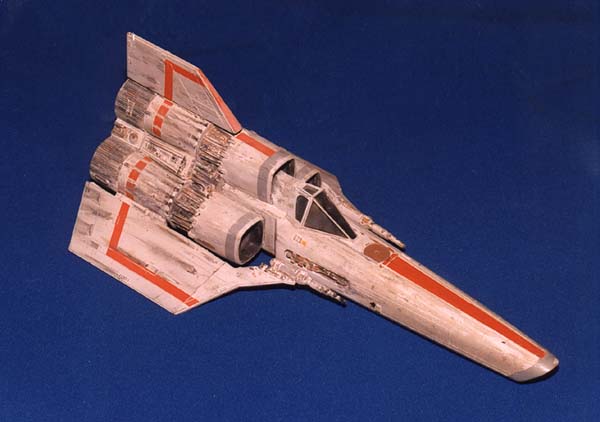
Colonial Point Defense Fighter
Web site by: Phil
Broad
Studio
Miniature:
This model (also seen above)
is typical of the type built to be exploded or damaged in some way.
Full
Scale Mock-up:
This is a series of photos taken
of the studio mock-up over about a two year period.
Cockpit
Set:
These are a few shots of the
Viper cockpit. Unfortunately they were taken with ASA 400 film and
a "half frame" camera so they are quite grainy.
Fan
Built Miniatures:
These are shots of Viper miniatures
built by fans of the show.
Galactica
After the stunning and surprise success of "Star Wars" in the mid '70s the search was on for a television property that might cash-in on all the "space opera" fervor. When Universal Studios executives saw the presentation for "Galactica" by Glen A. Larson and Donald P. Bellisario they knew they had what they were looking for. Though written in the form of a cheap serial of the 1930s it would prove to be anything but. For its day "Galactica" was THE biggest budget TV series ever and Universal Studios was anything but confident about it. However there was already an energized market "ready for more" but would it grab the kind of market share required to support such huge weekly budgets? Only time would tell. To ensure as large an audience as possible, a great deal of pre publicity was created in order to generate advance interest, including appearances on Johnny Carson's "Tonight Show" by Jane Seymore, female lead of the three hour pilot episode. In the end "Galactica" would not be able to maintain the huge audience needed, even after budget cutting techniques were applied. During its short life, Galactica would acquire a large and loyal following which might have proven enough if the overhead cost had not been prohibitively high. This built-in audience was recognized several years after the shows cancellation when it was revived as "Galactica 1980". Featuring even smaller budgets, the fans soon abandoned this poor attempt at a new series. Today some people still hope to revive the series once again but who knows if the Battlestar Galactica shall threaten the Cylon Empire once more. For myself, I would like to think that it will.
The Viper as Modeled
Advanced marketing for the original series included model kits of the primary spacecraft which were released many months ahead of the actual TV premiere date. Designed by Joe Johnston and Ralph McQuarrie, these ships had the same mechanical "feel" as those used in "Star Wars" yet were completely new designs. One of the design criteria for the Viper would be a "compact" configuration, easy to produce as a full-scale set piece, yet projecting a feeling of power. This was achieved with admirable results, at a diminutive length of 27 feet the Vipers huge intakes and exhaust nozzles left no doubt that this was a high-powered combat vehicle. Sporting stub wings reminiscent of the X-15 or F-104 Starfighter and a long rakish nose, this design also featured simple to build shapes that helped keep construction budgets down. Built as miniatures first, they also presented certain challenges to the studio construction department. Namely, how to reproduce those shapes that were applied to the models in the form parts borrowed from commercial model kits? In the end this was accomplished by making those parts as full scale vacuum formed plastic panels. For current model builders this posses an interesting question; is the studio mock-up the "actual" Viper or are the Hero models the "actual" Vipers? Since each are different in detail owing to different construction techniques, which should one follow when building a model?
The answer is "both and neither". Since these are both examples of "studio" construction, neither exhibits the detail that would be found on the "actual" craft. Rather, they are only representational of the "real" fighters. This leaves model builders with comfortable "wiggle room" to embellish the designs with details that might be found on real spacecraft but deemed too unimportant to include on a studio mock-up or too small to be seen on a model. The commercial model kits proved to be excellent replicas of the original miniatures, an outstanding product for fans of the show and sold for very reasonable prices.
Where is it now?
For many years the full scale Viper mockup languished in semi-outdoor storage behind one of the false front buildings on Universals Studios "New York" street back lot. Then came a fire that burned down that portion of the back lot and it is presumed that the Viper went with it. It is also possible that it was scrapped even before the fire, like so many of the other studio "spaceships".
Please contact me if you have comments about these images or corrections to the information presented here via E-Mail.